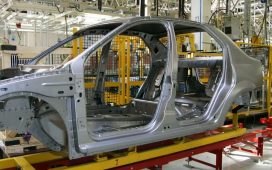![U.S. President Donald Trump speaks at a dinner with Senate Republicans at Mar-a-Lago in Palm Beach, Florida, on Feb. 7. [AP/YONHAP]](https://www.wiredfocus.com/wp-content/uploads/2025/02/How-Trump039s-threatened-tariffs-on-cars-and-chips-could-devastate.jpg)
U.S. President Donald Trump speaks at a dinner with Senate Republicans at Mar-a-Lago in Palm Beach, Florida, on Feb. 7. [AP/YONHAP]
Korean automobile and chip companies got caught in Donald Trump’s turbulent trade tussle as the new U.S. President teased a potential tariff on car and chip imports, two of Korea’s biggest categories that make up more than 40 percent of its total exports to the United States.
Trump hinted Monday he was “looking at tariffs on cars, semiconductor chips and pharmaceuticals,” making his remark dependable, as it was made after he officially declared a 25 percent tariff on all steel and aluminum foreign imports with “no exceptions and exemptions.”
Vehicles are considered Trump’s most urgent target for now, as it is currently the category marking the biggest surplus in U.S. trade.
Korea’s car exports to the United States recorded $34.74 billion last year, becoming the No. 1 category, making up 27.2 percent of the country’s U.S. exports, according to the Korea International Trade Association. In that full year, Korea’s auto imports from the United States stayed only at $2.1 billion. Auto parts exports stood at $8.2 billion, making up 6.4 percent.
![Vehicles wait to be exported at a port in Pyeongtaek, Gyeonggi, on Feb. 11. [YONHAP]](https://www.wiredfocus.com/wp-content/uploads/2025/02/1739268644_511_How-Trump039s-threatened-tariffs-on-cars-and-chips-could-devastate.jpg)
Vehicles wait to be exported at a port in Pyeongtaek, Gyeonggi, on Feb. 11. [YONHAP]
Hyundai Motor and Kia are heavily dependent on the U.S. market, with one of four of their produced cars sold on the U.S. market. The two largest Korean automakers sold a record-high 1.71 million cars in the U.S. market in 2024, placing No. 4 after General Motors (GM), Toyota Motor and Ford Motor.
Korea Investment & Securities estimated that in a scenario of the U.S. government imposing 10 percent on Korea-made vehicles and 25 percent on Mexico-made cars, Hyundai Motor will suffer 1.9 trillion won ($1.3 billion) of fall in operating profit while Kia would fall 2 trillion won.
GM Korea is also highly reliant on U.S. exports, with around 90 percent of its production in Korea going to the U.S. market. Its Trax crossover was Korea’s No. 1 exported car last year, with 295,099 units exported overseas, and of that, 84 percent went to the United States.
Renault Korea will also start producing Polestar 4 EVs at its Busan plant, with the aim to export to the U.S. market.
“Auto and chips are such a huge part of Korea’s exports [to the United States], so if they take a hit, it will have a discernible impact,” Jung Kyu-chul, director of the office of macroeconomic analysis and forecasting at the Korea Development Institute, said during a press briefing Tuesday.
When asked if the rate could plummet to the early 1 percent range if tariff institution is realized in those two sectors, Jung said such a possibility is “hard to deny” considering the portion chips and auto take up in Korea’s export landscape.
The Trump administration’s potential tariffs on semiconductors could also deal a blow to Korea’s chip industry, which has been prioritizing U.S. sales while distancing itself from China amid the ongoing chip war between the two countries.
Last year, Korea exported $10.6 billion worth of chips to the United States, taking up about 7.5 percent of the total exported volume of chips.
Although the portion may not seem big as a stand-alone figure, Korea has been expanding its presence in the U.S. over the years, nearly doubling from $4.9 billion in 2023.
Samsung Electronics reported U.S. sales of 92.1 trillion won in 2023, spanning semiconductors, mobile devices and home appliances. The United States was its largest market, contributing 35 percent of total sales, followed by Asia, Africa and China, which, together, accounted for 28 percent.
SK hynix generated 27.3 trillion won in the United States as of the third quarter of last year, which accounted for 59 percent of its total revenue.
BY SARAH CHEA, JIN EUN-SOO [[email protected]]







